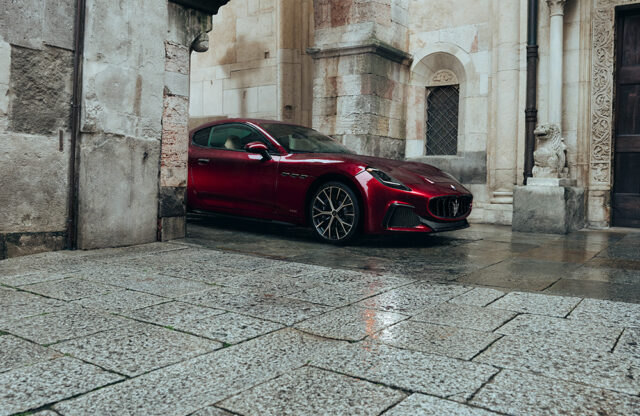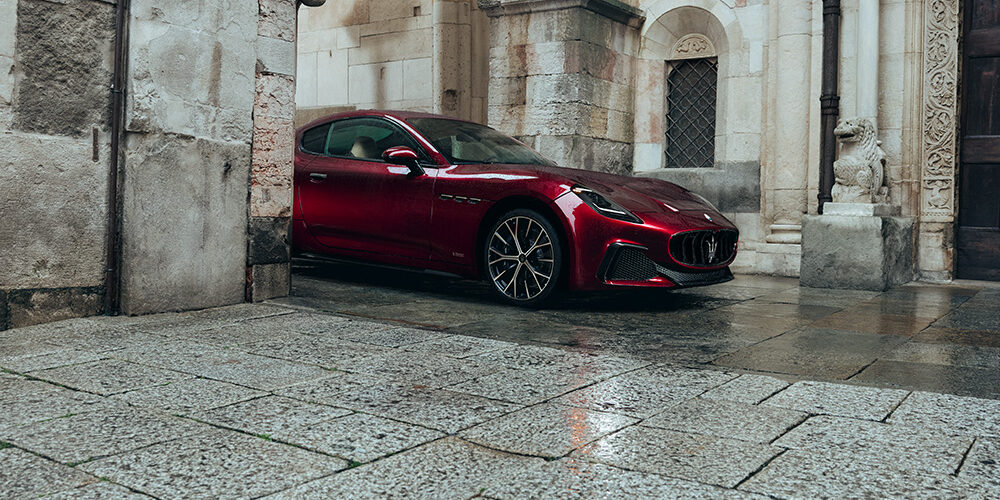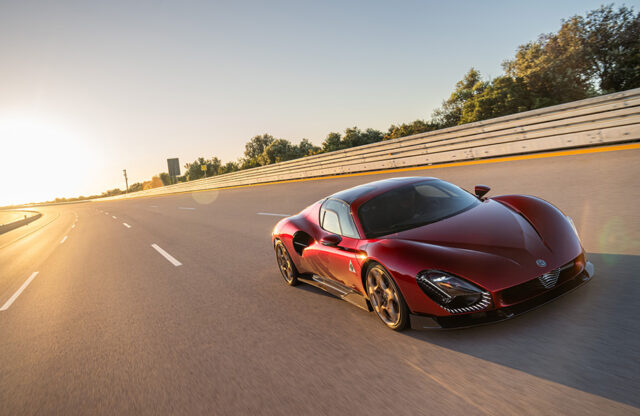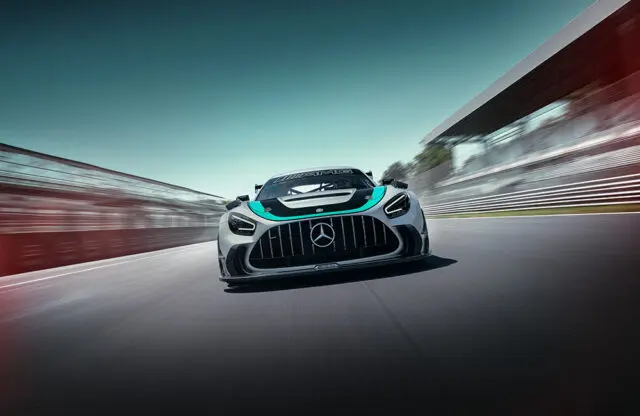Centring a brand relaunch around an opera is risky territory, but Maserati is no stranger to drama. Much like Aston Martin, its glorious history has had some distinctly inglorious moments – and, as with its British rival, the past few years have been stormy.
Magneto was invited to Modena for the relaunch of the brand under COO Santo Ficili and Maserati CEO Jean-Philippe Imparato, formerly of Alfa Romeo. Other than the Grecale SUV, all Maserati production will be brought back to Modena, with the GranCabrio and GranTurismo sharing production lines at the historic plant alongside the MC Pura variants and the MC20 GT2 Stradale. This follows the closer integration of Alfa Romeo and Maserati’s heritage, motor racing, customisation and few-offs division into BottegaFuoriserie, which we brought you details of last week.

Just prior to a performance of Puccini’s Turandot at the Pavarotti–Freni Theatre, Ficili spoke of the reason to return to Modena. “This marks a strategic choice, reaffirming the deep bond between the brand, the city and their shared history,” he said. “It’s not only a symbolic decision, but an industrial one, too. While in Turin the production of the new hybrid and electric Fiat 500s is under way, Modena returns to what it does best – creating truly exclusive cars, built with craftsmanship and mechanical precision, where technology meets the human touch. This decision reinforces Modena’s role as the beating heart of our future and a benchmark for Italian motoring excellence – the place where Maserati’s roots truly lie.”
To make that happen, significant investment has been made in the movement of production. “In this spirit, Maserati renews its commitment to the region with tangible investments – from modernising the factory and bespoke workshops to reviving the Maserati Classiche programme,” he said. “The new BottegaFuoriserie will serve as a creative laboratory for personalisation, dedicated to our customers.”
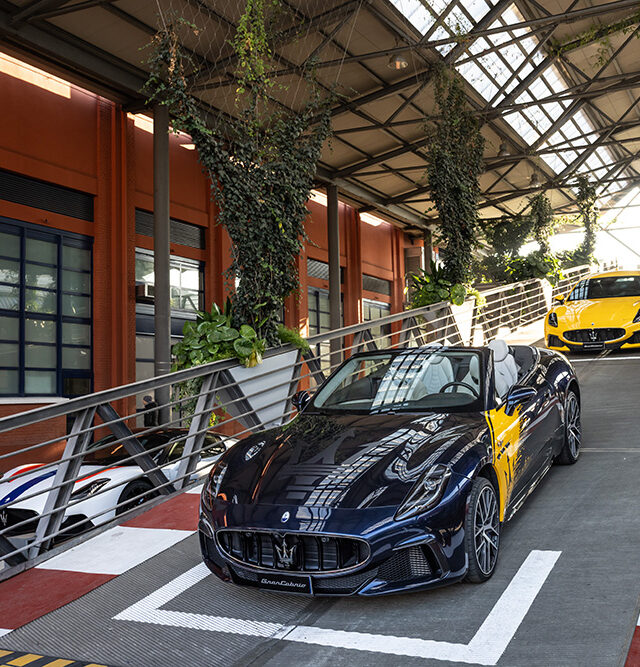

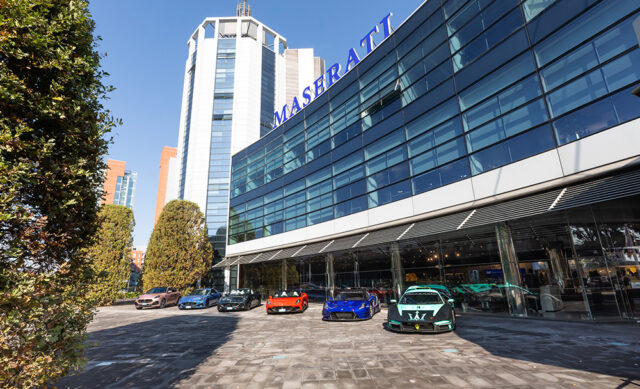
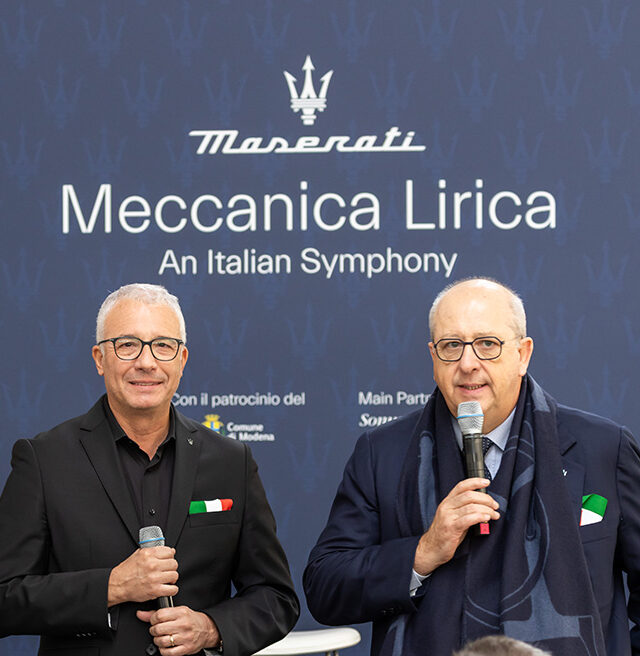
It represents a complete departure from the mass-market strategy that Maserati was steered into around 15 years ago under Harald Wester and Sergio Marchionne, with the Ghibli III, Levante and Quattroporte VI. While many scoffed – Maserati’s previous attempt at volume production with the Biturbo hadn’t gone smoothly – it was initially successful. In 2013, sales doubled compared with 2012, and in 2014 they grew by 169 percent. Ambitious targets were set for 2018, with 70,000 cars projected to be sold worldwide.
However, in a pattern familiar to long-time observers of the Italian car industry, several recurring issues emerged. The models fell behind their German rivals in product development, and later updates were introduced in ways that alienated dealerships. Forcing 2.0-litre petrol hybrids and diesels onto Ferrari-Maserati dealers – who had little demand for them yet were obliged to take stock they couldn’t sell, even at a loss – prompted several long-standing partners to walk away, including one who had almost single-handedly sustained the marque’s presence in the UK.
Sales collapsed, and resale values – never a traditional Maserati strength – deteriorated further. Eventually, the former Bertone factory, which had been building the Ghibli and Quattroporte, closed its doors for good. Unfortunately, poor communication from Maserati about the one-off cost of the closure and its effect on the balance sheet triggered a wave of misleading ‘Maserati in crisis’ headlines. A year later, and partly as a result of that negative coverage, the crisis became real: sales declined further, more dealers departed and Stellantis CEO Carlos Tavares publicly questioned whether the historic brand should be closed or sold. Plans for an all-electric MC20 were cancelled, and €1.5 billion in EV investment was written off.
It has not been an easy period, but Santo Ficili and Jean-Philippe Imparato – the latter newly appointed this year – have had time to plot a viable path forward. Moving away from a mass-market model is now seen as the only realistic option.
The irony is that, now freed from Ferrari’s restrictive oversight, Maserati’s current products are among the strongest in its history. The MC20 has been widely praised by leading motoring titles, while the GranTurismo has received favourable reviews. The main challenges remain pricing and some detail execution, but the renewed focus on building to individual order is expected to help address both.

During the Maserati brand relaunch, a day after the Turandot performance and following a tour of the factory – including a brand-new Fuoriserie paint department capable of switching between different paints and even car models one by one, rather than in batches – Ficili and Imparato faced the press.
With the move to a build-to-order programme, Maserati’s Fuoriserie division is set to play a far more central role within the brand. “In terms of figures, the Fuoriserie business currently represents roughly 15 to 20 percent of our total revenue, depending on the model line. The ambition is to double that within the next three years,” said Ficili. “This isn’t just about painting a car in a different colour – it’s about craftsmanship, material quality, interior personalisation and creating unique experiences for the customer. That’s why we’re investing heavily in this area.
“We’re developing dedicated teams, new training programmes for our artisans and digital tools that allow customers and dealers to configure their bespoke models in real time. It’s a complete ecosystem, not a side activity – it’s a philosophy. We’re not chasing volume; we’re chasing excellence. We want every Maserati built in Modena to be a piece of Italian artistry – technically perfect and emotionally captivating. Our processes are intentionally hands-on: you’ll find digital tools everywhere, but the final touch is always human. That combination of precision engineering and craftsmanship is what defines a boutique manufacturer.”
“Here, we can do things others can’t,” Imparato added. “We can innovate quickly, create unique editions and involve the customer directly in the design process. That’s the kind of flexibility you lose when you’re building hundreds of thousands of cars a year.”
To demonstrate the possibilities, Maserati unveiled two new cars – one GranCabrio and one GranTurismo – both showcasing the full potential of the Fuoriserie programme. The division now has a dedicated space at the Modena headquarters, where clients can explore materials up close, enjoy one-on-one consultations and view 3D renderings of their personalised creations. Material quality on these Fuoriserie models showed a marked improvement over the standard cars, with richer Alcantara, finer detailing and noticeably higher levels of surface finishing.

The relationship between Maserati and its workers has been a tricky one over the past few years. Even though the company is moving away from mass production, it is placing renewed emphasis on craftsmanship. “We’ve reshaped the plant to make it leaner and focused purely on high-value production. That means fewer repetitive tasks and more skilled craftsmanship. We’ve invested in training, digitalisation and quality control, and we’ll continue selective hiring – especially in software, testing and Fuoriserie,” Ficili explained.
Maserati still has electrification plans – even if the MCPura may be skipped. “The GranTurismo Folgore, developed and built right here, isn’t a converted petrol car – it was designed from day one as a pure electric Maserati,” Ficili said. “Customer deliveries begin shortly. We’re proud that Modena continues to be a hub of technology and craftsmanship, evolving without losing its soul.”

Maserati is keen to engage with its dealers around the world. “To keep Modena running, everything related to the GT, GC and MC must remain centred here. Consolidating volumes is crucial to managing costs effectively. We’ve done the maths: we know precisely how many cars we need to sell each year to keep Maserati profitable. The Fuoriserie programme, alongside the GT and GC, is a key part of that plan,” Ficili said. “We’re meeting every Maserati dealer in the world – around 200 of them — to bring them into the factory, present the 2026 programme and showcase BottegaFuoriserie. The goal is to create not just sales, but excitement, pride and visibility. All of that is set to happen before the end of the year.”
Asked whether the move back to Modena has improved quality, it’s clear that was part of the plan. “When you make this kind of capital investment, it’s not just about cost-cutting,” explained Imparato. “We took the decision in late 2024 to focus on Mirafiori for the 500e project, then build on that and transfer GT and GC production here to Modena. Of course, it requires investment – roughly €4,000,000. So in the short term, it costs something. But the effect on quality and efficiency is immense.
“We expect a return on investment within 24 months – very fast for this kind of move. It was a necessary and coherent decision because Modena is, and must remain, the core of Maserati. To protect quality, we’re also reducing stock and ending the old push-to-sell approach. We don’t rush production any more. If you want the red one, you’ll wait six months – because we won’t compromise on quality. We’re moving from a mass-production mentality to a bespoke, B2B-oriented strategy.”
Imparato is very clear on the need for quality, after his experience overseeing the Alfa Romeo 33 Bottega programme. “Our most passionate collectors – those who buy cars worth several million – are unforgiving when it comes to respect and quality. One mistake, one oversight, and you lose them,” he said. “That’s why it’s absolutely forbidden for us to release a car that isn’t perfect. If the car is perfect, we ship it. If not, it stays. Full stop. This level of confidence also allows us to expand the Maserati Approved programme – something we’ll go deeper into at the beginning of 2026.”

But what of the Quattroporte? It’s a stalwart model within the brand, but the Trident has been without a four-door sedan for several years. “Would we like Maserati to become only an SUV brand? Absolutely not,” Imparato said. “The question is whether we can find a sustainable business model for a future evolution of our saloon – and we’re working on that. Are we ready to announce or confirm anything today? No, not yet. But I’ll tell you this: I don’t want Maserati to be like everyone else. I want to create something that makes people dream. I want customers to come to us and say: ‘Please, I must have this car.’ And I’ll answer: ‘Give me a year, my friend, and it will be yours.’
“That’s the spirit – the essence of Maserati. Our answer for the D and E segments globally – for both private clients and business customers – will come in due course. The Quattroporte project remains very much alive. We have the right platform, the right technology and everything we need. Now it’s about perfecting the recipe – cooking it carefully, here in Modena.”
“Once Stellantis formally communicates its wider programme, Maserati will have its own dedicated roadmap,” added Ficili. “Of course, we’re also looking at other segments – those where our history and identity already give us a strong foundation. You can easily imagine where we might go next.”
One of those directions could be a smaller Maserati, based on the Giorgio platform that underpins the GranTurismo. “Until the day I no longer have a licence to operate, Giorgio will live on,” Imparato added. “We’ve invested heavily, it’s a superb platform and we can adapt it further – even shorten the wheelbase if needed. With Euro 7 compliance, we now have a platform full of opportunities.”
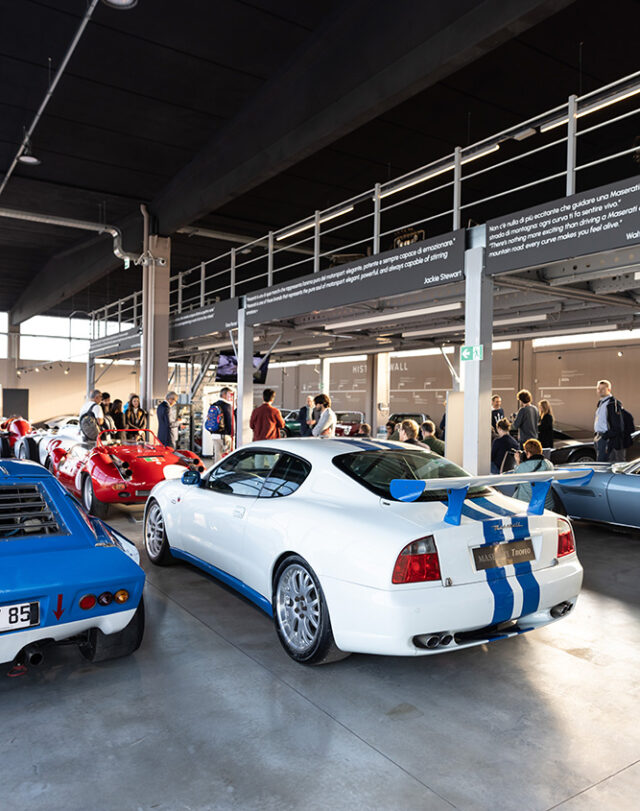
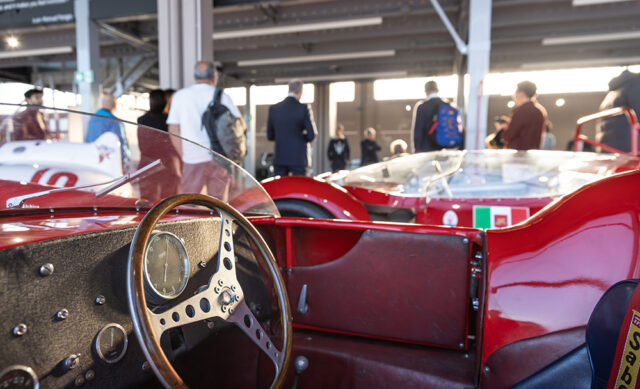

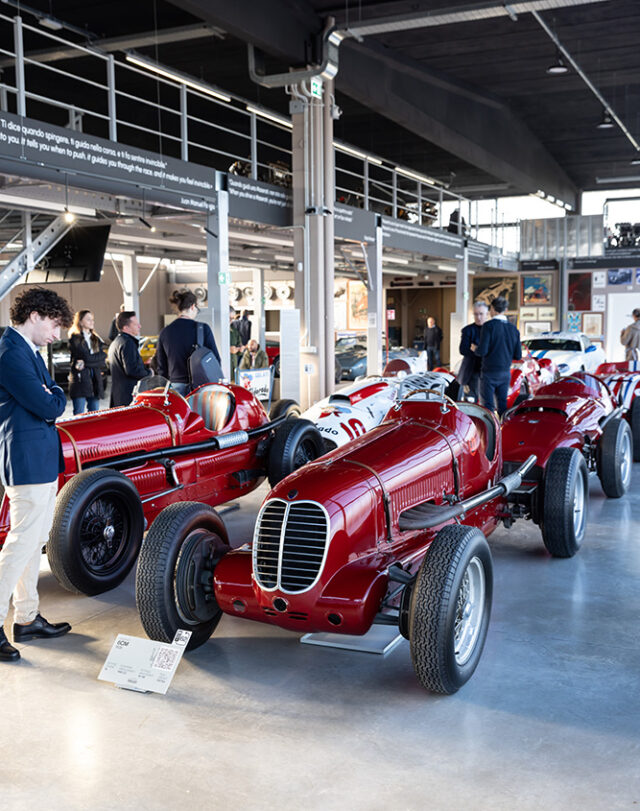
The Maserati brand relaunch event coincided with the official opening of the revitalised and relocated Maserati Umberto Panini Collection APS (pictured above). The marque has previously promised much when it comes to supporting its past catalogue, but the reality hasn’t always matched expectation.
Although the heritage division comes under the watch of BottegaFuoriserie head Cristiano Fiorio, Magneto asked Ficili and Imparato directly about the classic provision – and not just for high-value collectors.
“We’re fortunate – our past is full of extraordinary cars. It’s easy to look back and find inspiration. Here at Modena, under the umbrella of Maserati Classiche, we’re developing a programme that looks both backward and forward – one that celebrates heritage while enabling future restoration and certification,” Ficili said. “There are thousands of Maseratis still being driven around the world. They’re valuable, emotional, and they represent our history. That’s why we’re building Officine Classiche Maserati here in Modena – to support those owners. Our vision is to create a global network of certified workshops, capable of maintaining, restoring and even 3D-printing parts for Maseratis of any generation – all coordinated from here in Modena.”
Imparato’s main focus is Maserati’s P&L, but he has strong form not only for embracing automotive history but also for seeing its value as a key part of the brand; witness his efforts at Alfa Romeo.
“Maserati is now 111 years old – a true treasure trove of automotive art,” he said. “Under the Bottega Modenese concept, we want to extend the Maserati Classiche programme globally, training and supporting our network to increase sustainability, quality and expertise. We’re integrating new technologies such as 3D printing to reproduce parts and preserve vehicles at every level – from rare classics to more recent models. It’s not only about passion; it’s also a smart business move that strengthens our brand, supports our dealers and protects the long-term value of Maserati cars worldwide.”

The MCXtrema programme has prompted questions about developing the platform into a fully fledged racing-car programme. Maserati has won the GT2 series again this year, but the appetite behind the scenes is to go much further. “We love competition, and we’re working on the next steps. A dedicated team will soon communicate what comes next,” Ficili said.
However, Imparato’s job is to get the balance sheet sorted out – but even he is open to the idea. “We must consolidate what we’ve built – secure the foundations, ensure reliability and maintain excellence. Formula 1 is far too expensive today; endurance racing offers a more realistic way to test technology and durability,” he said. Asked specifically about WEC, he raised a smile. “If it’s financially sustainable, we’ll run – with the right partners and the right vision. But for now, we’re focusing on delivering solid, profitable performance before dreaming further.”
This does raise a broader question – Ferrari has a non-compete clause with any of the Stellantis brands due to a shared chairman; does this mean Ferrari might leave WEC? That wasn’t a question for today…

So can dreams become reality? Maserati was always going to struggle to keep up with the relentless pace of development from the German and German-attached brands, and returning to a build-to-order model taps into the brand’s most marketable element – Italian exclusivity. There remain question marks over hybridisation – something for which Bentley has experienced great demand with its product range, yet is absent from the GranTurismo/GranCabrio line-up. There are also ongoing headwinds from American tariffs and waning Chinese demand for Western luxury goods.
Ficili acknowledges all of this. “In business, there are always questions, always challenges. But what defines a great brand is its ability to stay true to itself while evolving. Maserati is doing exactly that. We’re modernising, we’re electrifying, we’re competing globally – and we’re doing it without compromising the Italian artistry that makes us who we are,” he said. “We’ve set clear goals, and we have the people and the products to achieve them. From Modena, we’re writing a new chapter in the story of Maserati – one built on courage, excellence and a very simple idea: beauty with purpose.”
I got the sense that this wasn’t a simple brand relaunch for journalists. It felt more like a galvanising mission for the whole company, and for a factory that’s had some very glum times of late. “Today isn’t just about launching cars – it’s about reaffirming who we are,” Imparato said. “Maserati has always represented a perfect blend of performance, design and emotion. Bringing production of the GranTurismo and GranCabrio back to Modena is more than a logistical choice; it’s a statement of identity. Every Maserati carries the soul of this city – its skill, its passion, its daring. What happens inside these walls isn’t simply manufacturing; it’s creation. And that’s something we’ll never lose sight of.”
More details on Maserati here.
